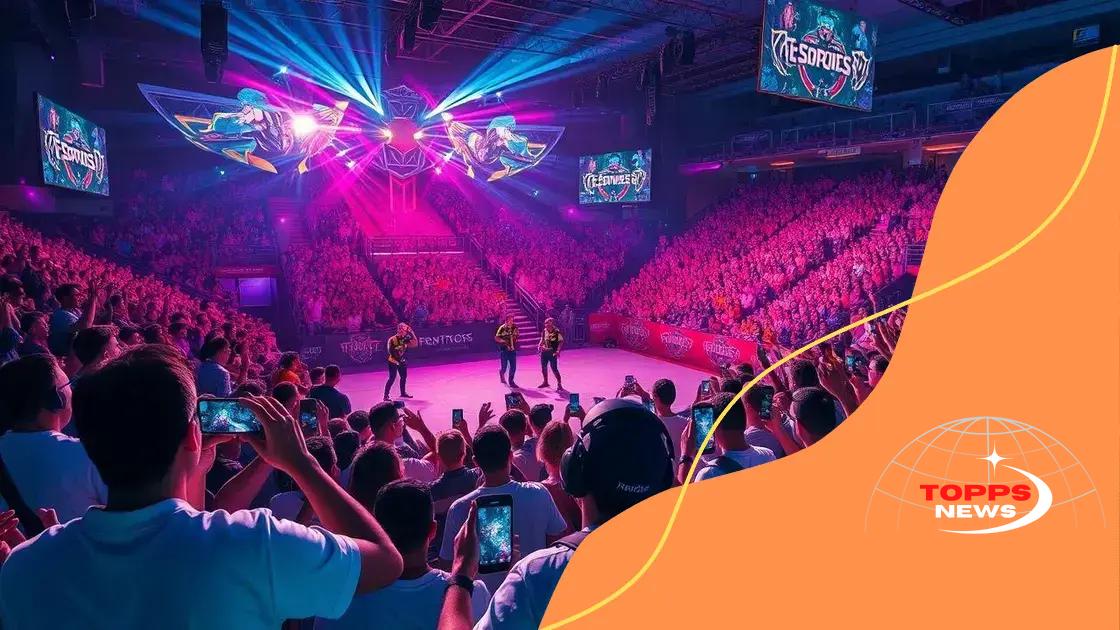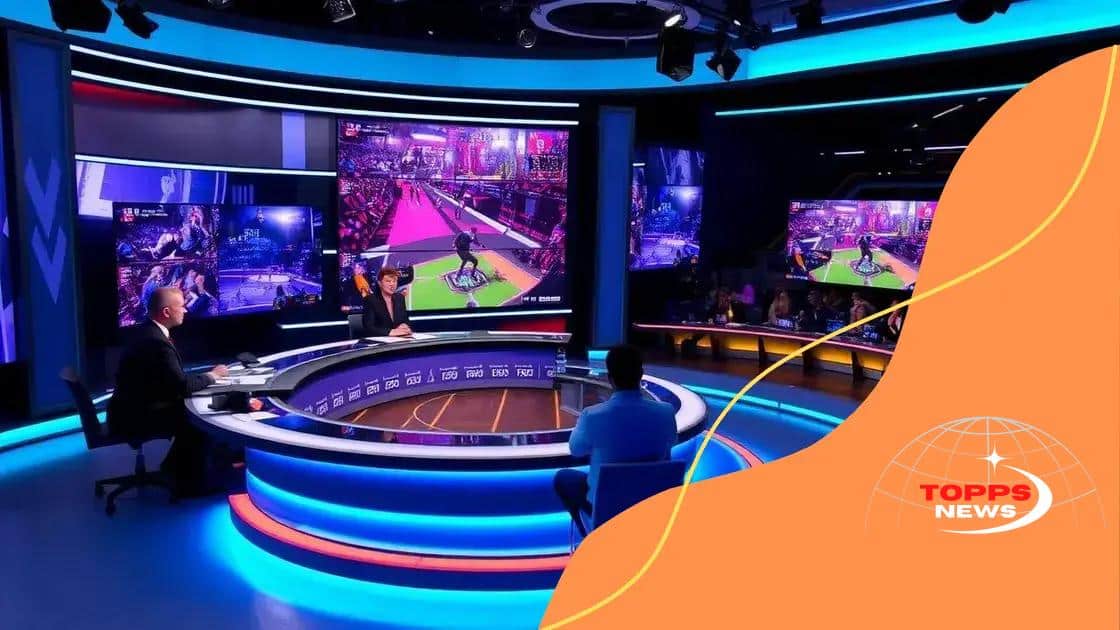How e-sports are influencing mainstream media content

How e-sports are influencing mainstream media encompasses growing audience engagement, increased live event coverage, and innovative advertising strategies, shaping the future of entertainment and brand collaboration.
How e-sports are influencing mainstream media content is a question many are asking as gaming becomes a key player in entertainment. Have you noticed how often e-sports are popping up in your favorite shows and platforms? It’s transforming the landscape.
Understanding the rise of e-sports
The rise of e-sports has been nothing short of phenomenal in recent years. Many people now tune in to watch their favorite gamers compete, just as they would for traditional sports. This excitement has attracted millions of fans globally, and it continues to grow.
So, what contributes to the rise of e-sports? One pivotal factor is the accessibility of gaming platforms. With the increase in internet connectivity and the popularity of streaming services, gamers can showcase their skills to wider audiences. Furthermore, major companies are beginning to invest significantly in this domain.
Factors Influencing Growth
The surge in popularity of e-sports can be attributed to several key aspects:
- Increased accessibility: More gamers can join the action thanks to affordable gaming hardware and improved internet connections.
- Sponsorship and investment: Big brands are recognizing the potential and are investing heavily in e-sports events and players.
- Community engagement: Many gamers feel a sense of belonging in the e-sports community, which fosters loyalty and participation.
Additionally, e-sports events are being held in large arenas, attracting thousands of attendees. These tournaments often offer substantial prize pools, encouraging top-tier players to participate. The excitement and competitive spirit bring together both gamers and fans, creating a vibrant atmosphere.
Moreover, social media and streaming platforms like Twitch make it easy for fans to follow their favorite players and teams. This interaction strengthens the connection between fans and the e-sports community.
The Role of Mainstream Media
Mainstream media is also starting to pay attention to e-sports. News outlets and channels are covering e-sports events, leading to greater exposure and legitimacy. This recognition helps to bridge the gap between traditional sports and e-sports, making the latter more accepted.
As e-sports continue to gain traction, it is essential for stakeholders, including gamers, brands, and media platforms, to collaborate. By uniting efforts, they can ensure a thriving future for e-sports that benefits all parties involved.
Key partnerships between e-sports and media
Key partnerships between e-sports and media are essential for the growth and visibility of the industry. These collaborations have opened doors for e-sports to reach wider audiences, making it a staple in the entertainment world.
One significant aspect of these partnerships is the collaboration between game developers and media networks. By working together, they create tailored content that showcases competitions and players. This synergy allows for unique storytelling opportunities that help attract more fans.
Types of Partnerships
Various partnerships shape the landscape of e-sports. Here’s a look at some essential types:
- Broadcasting arrangements: Major networks are securing deals to air e-sports tournaments live, bringing competitions into households nationwide.
- Sponsorships: Brands are sponsoring teams and individual players, helping them gain the financial backing needed to compete at higher levels.
- Media coverage: News outlets are beginning to cover e-sports regularly, providing updates, analysis, and interviews that help legitimize the sport.
Furthermore, social media platforms have become an avenue for e-sports athletes to connect directly with their fans. These platforms provide a space for real-time engagement and updates, making e-sports even more accessible.
As media companies take notice of these trends, the quality of e-sports content continues to improve. More professionals are entering the field, creating high-production-value broadcasts that enhance viewer experience. This evolution helps e-sports compete with traditional sports and further establishes its position in the mainstream media narrative.
The impact of e-sports on traditional broadcasting

The impact of e-sports on traditional broadcasting has significantly changed the landscape of how audiences consume entertainment. As more viewers flock to e-sports, traditional broadcasters are adjusting their strategies to attract and engage this growing audience.
This shift has led to a new era of broadcasting where e-sports tournaments are showcased on television and streaming platforms. Many networks are now airing live events, providing a unique opportunity for fans to enjoy their favorite games while discovering new ones. This integration presents opportunities for conventional sports networks to capture a younger demographic that has traditionally focused on online content.
Changes in Broadcasting Strategy
With the rise of e-sports, broadcasting strategies have transformed in several ways:
- Live coverage: Networks now feature live e-sports tournaments, enabling viewers to watch real-time competitions as they unfold.
- Specialized content: Channels are producing documentaries and analysis shows dedicated to e-sports, diving deeper into player backgrounds and game strategies.
- Interactive experiences: Viewers can engage via social media during broadcasts, creating a community of fans sharing insights and commentary.
Furthermore, traditional broadcasting has embraced e-sports as a legitimate form of competition, similar to traditional sports. This acknowledgment not only enhances its status but also encourages younger audiences to partake in e-sports.
The demand for high-quality production values in e-sports broadcasts has increased as well. Viewers expect a polished experience, including professional commentary, graphics, and live statistics. As broadcasters invest in these enhancements, they create a more entertaining and immersive viewing experience. Ultimately, the blending of e-sports and traditional broadcasting is reshaping content delivery and audience engagement.
Trends in advertising around e-sports
Trends in advertising around e-sports are rapidly evolving, reflecting the growing popularity of competitive gaming. Advertisers are increasingly recognizing the opportunities that e-sports present for reaching key demographics, especially younger audiences.
Brands are now creating custom campaigns that directly engage with the gaming community. This strategy allows them to connect with fans in a more meaningful way than traditional advertising methods.
Types of Advertising Strategies
Several advertising strategies are becoming prominent in the e-sports landscape:
- In-game advertisements: Companies place ads within the games themselves, promoting their products in a seamless way that does not disrupt gameplay.
- Sponsorships: Brands are sponsoring teams and tournaments, gaining exposure during events while building a connection with fans.
- Influencer partnerships: Popular streamers and gamers endorse products, leveraging their influence to reach dedicated audiences.
Furthermore, e-sports tournaments are often broadcast live, creating a prime opportunity for advertisers to reach viewers in real-time. During these broadcasts, commercials may feature targeted ads aligned with viewer interests, enhancing engagement.
As e-sports grows, innovative advertising formats continue to emerge. For instance, augmented reality experiences are being used to create immersive ads that captivate gamers. This technology allows brands to bring their messages to life in a way that traditional ads cannot.
Overall, as the e-sports industry expands, advertisers will need to adapt quickly to keep pace with these trends. The ability to understand and engage with gamers will be crucial for brands wanting to thrive in this dynamic field.
The future of e-sports in mainstream media
The future of e-sports in mainstream media looks brighter than ever as the industry continues to expand and reshape how we view entertainment. More viewers are tuning in to watch gaming competitions, signaling a shift in audience preferences. Traditional media channels are adapting to incorporate e-sports, making it a central aspect of their programming.
As this trend grows, we can expect to see even more collaborations between e-sports and mainstream media. Prominent networks are already airing e-sports tournaments, which helps validate its status as a legitimate sport. This integration fosters greater awareness and acceptance among casual viewers who may not have previously engaged with gaming.
Upcoming Trends in E-sports Media
Several emerging trends indicate how e-sports will shape the future of mainstream media:
- Increased live events: There will be a rise in live tournaments broadcasted on multiple platforms, allowing fans to engage directly with competitions.
- Enhanced viewer experiences: Innovative technology such as virtual reality (VR) will enhance the way audiences experience e-sports, making it more immersive.
- Crossover content: Expect collaborations between popular TV shows and e-sports events, creating unique content that appeals to both gamers and non-gamers.
This evolving landscape will also lead to more investment from brands looking to capitalize on the growing audience engagement. Sponsors will want a piece of the action as e-sports continues to capture attention. Additionally, media companies are likely to develop original content focused on e-sports personalities and behind-the-scenes stories.
As gaming communities grow and diversify, anticipating these changes will be crucial for adapting media strategies. By recognizing the cultural significance of e-sports, traditional media can better serve their audiences and continue to thrive alongside this exciting new frontier.
FAQ – Frequently Asked Questions about E-sports and Mainstream Media
How are e-sports changing traditional media?
E-sports are influencing traditional media by incorporating live tournaments and specialized content to attract younger audiences.
What opportunities do brands have in the e-sports industry?
Brands can engage with fans through sponsorships, in-game advertisements, and influencer partnerships to promote their products.
What trends are shaping the future of e-sports in mainstream media?
Emerging trends include increased live event coverage, immersive viewer experiences, and crossover content with popular entertainment.
How can e-sports improve audience engagement?
E-sports can enhance audience engagement through interactive content, real-time social media interaction, and personalized experiences.





